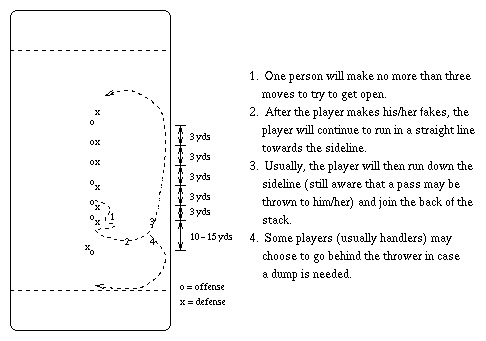|
|
|
Patience is a virtue, especially when playing offense.
In ultimate, unlike most other sports, the person with the disc can't
move. This means that the receivers must work extra hard to get open
for the thrower. The best way to work the disc up the field is to
create open space for the disc to be thrown and for people to run.
One way of creating lots of space is for everyone to line up in the
centre of the field. This is called a stack and is diagrammed
below.
This creates two open spaces for
the disc to be thrown. People may then leave the stack (ideally, one
at a time) and run to one of the open areas. The best throw to the
receiver would be one that curves from the outside and goes in towards
the receiver (see the diagram below)
If the receiver does not quickly get open, he/she must
clear the area by either running long down the sideline (the usual
clearing cut) or going behind the thrower (done less often). (The
entire cutting process is shown below.
If the defender doesn't follow the receiver (i.e. poaches),
the receiver
should look to get open from everyone for an easy immediate pass or a
later pass (usually by running down the field, keeping to the
sideline). This player will yell, ``poach!'' to let the thrower know
that there is a defender sitting in a passing lane and to draw attention
to his/herself.
To summarize, the role of the receiver is to
The give and go play is simple but dynamic (see above figure)
Usually it is run
off of a short pass. The cut begins with the thrower. Once the disc
leaves the thrower's hand, the thrower is running. The release of the
throw and the beginning of the run happen instantaneously. Since the
thrower knows when he/she is going to throw the disc (unlike his/her
defender), he/she will usually be open after his/her first step. The
receiver of the short throw then looks to throw the disc back to the
original thrower. (Note: Running right after you throw is a good idea
no matter what the situation.)
There are other ways to create space besides using a stack. One way
is to have four of the seven players run down field. This leaves lots
of room for the remaining three players to run (see above figure).
In essence, you have
isolated three players to move the disc up the field and hence
this play is called the iso. The players in the iso are then
free to move the disc anyway they can to at least half field.
Usually, many give and goes are used to move the disc.

The stack is used to create space for people to run
and the disc to be thrown. There should be enough room between
players in the stack so that any one of them can run from the stack
without risking having their defender run into anyone (called a
pick). Take note of the areas that are shaded.
These are the areas that the receiver should expect the disc.

The thrower wants to make a throw that allows his/her teammate
to run in to the disc while making it hard for the defender to
touch the disc. This leads to putting a certain edge on
the disc depending on which way the thrower is being marked.

One person will leave the stack and try to get open. If
they don't get open they must clear the area to give room for
another person to cut.
The key is to keep lots of space clear for the disc to be thrown there
and for people to run there. The role of the thrower is to
Throwing a dump is usually easy because the defense is not concerned
if the offense moves the disc backwards. Dumps take place in the region
behind the thrower as diagrammed above. Once the thrower
decides to
throw a dump, he/she will pivot so that his/her endzone is now to
his/her back. He/she will take note of which side of the
receiver the defender is positioned and look to throw the disc to the
opposite side. He/she will then make eye contact with the receiver and
throw a short pass to the open side of the receiver allowing the
receiver to run to the disc. In most cases, dumps can be used to
break the defense's force or to initiate a give and go cut.


Three players may try to work the disc up the field by
themselves if the other players give them room. So as not to
tip the play too early, the four remaining players usually
stay stacked and within about 25 yards of the disc, moving
back as the disc is advanced.